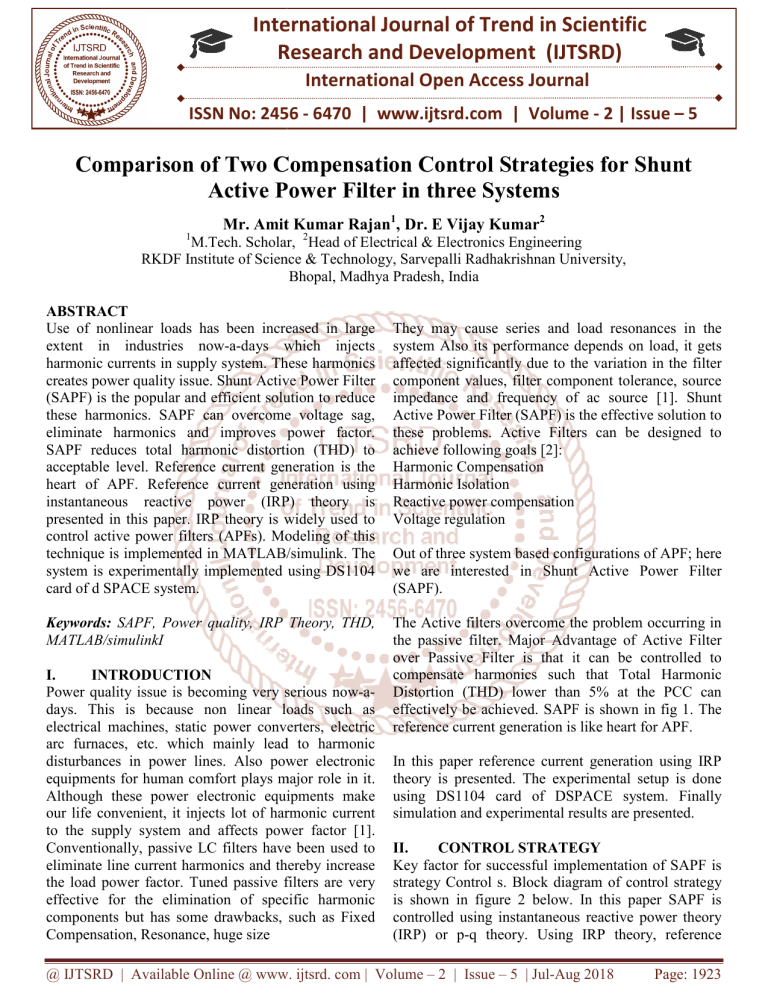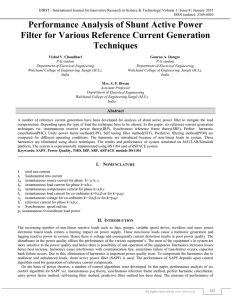
International Journal of Trend in Scientific
Research and Development (IJTSRD)
International Open Access Journal
ISSN No: 2456 - 6470 | www.ijtsrd.com | Volume - 2 | Issue – 5
Comparison of Two Compensati
Compensation
on Control Strategies for Shunt
Activee Power Filter in three Systems
1
Mr. Amit Kumar Rajan1, Dr. E Vijay Kumar2
M.Tech. Scholar,
cholar, 2Head of Electrical & Electronics Engineering
RKDF Institute of Science & Technology
Technology,, Sarvepalli Radhakrishnan University,
Uni
Bhopal, Madhya Pradesh, India
ABSTRACT
Use of nonlinear loads has been increased in large
extent in industries now-a-days
days which injects
harmonic currents in supply system. These harmonics
creates power quality issue. Shunt Active Power Filter
(SAPF) is the popular and efficient solution to reduce
these harmonics. SAPF can overcome voltage sag,
eliminate harmonics and improves power factor.
SAPF reduces total harmonic distortion (THD) to
acceptable level. Reference current generation is the
heart of APF. Reference current generation using
instantaneous reactive power (IRP) theory is
presented
ed in this paper. IRP theory is widely used to
control active power filters (APFs). Modeling of this
technique is implemented in MATLAB/simulink. The
system is experimentally implemented using DS1104
card of d SPACE system.
Keywords: SAPF, Power quality, IRP Theory, THD,
MATLAB/simulinkI
I.
INTRODUCTION
Power quality issue is becoming very serious now
now-adays. This is because non linear loads such as
electrical machines, static power converters, electric
arc furnaces, etc. which mainly lead to harmonic
disturbances in power lines. Also power electronic
equipments for human comfort plays major role in it.
Although these power electronic equipments make
our life convenient, it injects lot of harmonic current
to the supply system and affects power factor [1
[1].
Conventionally, passive LC filters have been used to
eliminate line current harmonics and thereby increase
the load power factor. Tuned passive filters are very
effective for the elimination of specific harmonic
components but has some drawbacks, such aas Fixed
Compensation, Resonance, huge size
They may cause series and load resonances in the
system Also its performance depends on load, it gets
affected significantly due to the variation in the filter
component values, filter component tolerance, source
impedance and frequency of ac source [1]. Shunt
Active Power Filter (SAPF) is the effective solution to
these problems. Active Filters can be designed to
achieve following goals [2]:
Harmonic Compensation
Harmonic Isolation
Reactive power compensation
Voltage regulation
Out of three system based configurations of APF; here
we are interested in Shunt Active Power Filter
(SAPF).
The Active filters overcome the problem occurring in
the passive filter. Major Advantage of Active Filter
over Passive Filter is that it can be controlled to
compensate harmonics such that Total Harmonic
Distortion (THD) lower than 5% at the PCC can
effectively be achieved. SAPF is shown in fig 1. The
reference current generation is like heart for APF.
In this paper reference current
rrent generation using IRP
theory is presented. The experimental setup is done
using DS1104 card of DSPACE system. Finally
simulation and experimental results are presented.
II.
CONTROL STRATEGY
Key factor for successful implementation of SAPF is
strategy Control s. Block diagram of control strategy
is shown in figure 2 below. In this paper SAPF is
controlled using instantaneous reactive power theory
(IRP) or p-q
q theory. Using IRP theory, reference
referenc
@ IJTSRD | Available Online @ www
www. ijtsrd. com | Volume – 2 | Issue – 5 | Jul-Aug
Aug 2018
Page: 1923
International Journal of Trend in Scientific Research and Development (IJTSRD) ISSN: 2456-6470
current will be generated. These reference currents
will be further used to generate gate pulses for
inverter. The basic principle of reference current
generation is shown
three phase balanced non linear load; as a result of
this following results are obtained. Following figures
5, 6 & 7 shows source voltage of phase A, source
current before compensation and source current after
compensation respectively.
III.
EXPERIMENTAL PROTOTYPE
The real time SAPF controller consist of dSPACE
DS1104 interfacing card, current and voltage sensors,
inverter consisting IGBTs as switches and a host
computer system. The interfacing kit is fixed in host
computer system. The experimental setup is as shown
in figure below in figure 4,
Figure2. Source voltage of phase A
Figure3. Source current before compensation
Figure1. Experimental setup
All the components of experimental are shown in
figure 4. Numbers in figure shows sequence of flow
of signals. As shown in figure, 3-phase supply is
given to Hall Effect voltage and current sensors.
Voltage and current sensor will convert three phase
supply to voltage signals suitable to dSPACE system
(0 to ±10 V). Further these converetd signals are
given to Analog to digital converter (ADC) ports of
dSPACE system. After simulation of control
technique in host computer system, signals will be
given to digital to analog converter (DAC) ports of
dSPACE system. Gating pulses are also generated
through host computer system and given to inverter
module through I/O ports of dSPACE system. After
that the whole system is connected to supply system
through small coupling inductor.
IV.
SIMULATION RESULTS
The
proposed
system
is
simulated
in
MATLAB/simulink along with the control technique
proposed in figure 2 and 3. The system is simulated in
MATLAB/ simulink having phase to phase 400v, and
frequency of 50 Hz. along with control technique, non
linear load and gate pulse generation. SAPF is
connected to supply system through very small
coupling inductor. The simulation is performed on
Figure4. Source current after compensation
The load current for phase A is obtained as fallows in
figure 5. Also filter current for phase A is obtained as
fallows in figures in figure 7
Figure5. Load Current for phase
Figure6. Filter current for phase A
THD of the given system shown in figure 11 below,
THD is found to be 2.91%
@ IJTSRD | Available Online @ www. ijtsrd. com | Volume – 2 | Issue – 5 | Jul-Aug 2018
Page: 1924
International Journal of Trend in Scientific Research and Development (IJTSRD) ISSN: 2456-6470
Figure07. THD of system
V.
EXPERIMENTAL RESULTS
The proposed system is experimentally performed
using DS1104 card of dSPACE system. The following
results are taken by using FLUKE 43B Power Quality
Analyzer,
Figure10. Active & Reactive power of phase c
The sum of all active powers in experimental setup
measured by FLUKE meter is found to be 3114W.
This value is verified by using dSPACE DS1104 card
is as shown below, and it is found to be 3098W.
The source voltage and current obtained are as fallows
in figure 8. Also figure 10 shows the reference
currents generated using p-q theory.
Figure8. Active & Reactive power of phase A
Figure11. Source voltage and current
Figure9. Active & Reactive power of phase B
VI.
CONCLUSION
Reference current is the key factor for successful
performance of SAPF. The reference current using
instantaneous reactive power theory is presented in
this paper. Further these reference currents are used to
generate switching pulses for inverter. THD can be
maintained to acceptable level using SAPF. The
simulation results using MATLAB/simulink verifies
that. The system is implemented by using dSPACE
DS1104. The experimental results are stated in the
paper. The advantages of IRP theory are that it is easy
to implement, less mathematical calculations. IRP or
p-q theory can effectively and efficiently be used to
control shunt active power filters.
@ IJTSRD | Available Online @ www. ijtsrd. com | Volume – 2 | Issue – 5 | Jul-Aug 2018
Page: 1925
International Journal of Trend in Scientific Research and Development (IJTSRD) ISSN: 2456-6470
VII.
1.
2.
3.
4.
5.
REFERENCES
M. Waware, P. Agarwal, “A Review of multilevel
Inverter Based Active Power Filter”, International
Journal of Computer and Electrical Engineering,
Vol. 3, No. 2, April, 2011 1793-8163 196
Musa Yusup Lada, Ismadi Bugis, Md Hairul
Nizam Talib, “Simulation a Shunt Active Power
Filter using MATLAB/Simulink” , The 4th
International Power Engineering and Optimization
Conf. (PEOCO2010), Shah Alam, Selangor,
MALAYSIA: 23-24 June 2010
María Isabel Milanés Montero, Enrique Romero
Cadaval, Fermín Barrero González, “Comparison
of Control Strategies for Shunt Active Power
Filters in Three-Phase Four-Wire Systems” , IEEE
transactions on power electronics, vol. 22, no. 1,
january 2007
Hirofumi
Akagi,
Hyosung
Kim,
“The
Instantaneous Power Theory on the Rotating p-q-r
Reference Frames” , IEEE 1999 International
Conference on Power Electronics and Drive
Systems, PEDS'99, July 1999, Hong Kong
Smita Singhai, Bharti Dewani, “Implementation
of
Active
Harmonic
Filter
with
6.
7.
8.
9.
MATLAB/Simulink to compensate Non-Linear
Loads” ,International Journal of Digital
Application and Contemporary research, Volume
1, Issue 9, April 2013
Maoh-Chin Jiang, “Analysis and Design of a
Novel Three-Phase Active Power Filter” , IEEE
transactions on aerospace and electronic systems
vol. 37, no. 3 july 2001
Jaime Prieto, Patricio Salmerón, Reyes S. Herrera,
“Practical Design of a Load Compensation Active
Conditioner”, project by the CICYT (Ministerio
de Ciencia y Tecnología, Spain).
N. Mendalek, K. AI-Haddad, F. Fnaiech and L. A.
Dessaint, “Nonlinear control technique to enhance
dynamic performance of a shunt active power
filter”, IEE Proc-Electr. Power Appl, Vol. 150,
No. 4, July 2003.
M. Suresh, S. S. Patnaik, Y. Suresh, Prof. A. K.
Panda, “Comparison of Two Compensation
Control Strategies for Shunt Active Power Filter
in Three Phase Four-Wire System” , 978-1-61284220-2/11/ ©2011 IEEE
@ IJTSRD | Available Online @ www. ijtsrd. com | Volume – 2 | Issue – 5 | Jul-Aug 2018
Page: 1926



